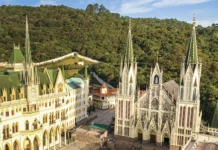The Polish custom of illuminating tombs and adorning them with flowers on All Souls’ day demonstrates the hope of reaching Paradise. And this expectation is strengthened with the conviction that the end of this life is the beginning of another without end, far superior and more beautiful!
Cemeteries, often gloomy and unwelcoming, take on a special colour on All Souls’ Day in Poland, owing to an ancient Catholic tradition. On this date, the Polish people customarily visit the sites where the bodies of their ancestors lie in order to pay them their respects, and, above all, to pray for their souls. In the local language, this commemoration is called Dzień Zaduszny, day of all souls.
The tribute begins on November 1, the Solemnity of All Saints. After attending Holy Mass, families gather at the graves to pray and to light blessed candles. These are left to burn throughout the night until they are consumed because, according to an innocent belief of medieval origin, they help the souls in Purgatory to attain the beatific vision.
On the following day, the Commemoration of All the Faithful Departed, the relatives again participate in the Holy Sacrifice and return to the cemetery to continue the prayers for the deceased. It is a magnificent offering of the Church Militant, extended to those who lived their faith in Christ and who have passed the threshold of eternity.
Scripture tells us that, after one of his battles, Judas Maccabaeus sent a collection to Jerusalem in order to offer a sacrifice for those who had perished. The sacred author comments on his deed: “In doing this he acted very well and honourably, taking account of the resurrection. For if he were not expecting that those who had fallen would rise again, it would have been superfluous and foolish to pray for the dead. But if he was looking to the splendid reward that is laid up for those who fall asleep in godliness, it was a holy and pious thought. Therefore he made atonement for the dead, that they might be delivered from their sin” (2 Mc 12:43-45). With the merits of the Redeeming Blood, this practice was taken to new heights, resulting in the custom that spread in Poland.
The diligence of the devout Poles in cleaning the graves, even those of strangers, and adorning them with colour and light reveals their nation’s spirit of pulchritude and piety. It is a noble tradition, faithfully handed down from parents to children, which teaches future generations the respect due to those from whom we have descended.
Moreover, an oft-repeated scene on the Dzień Zaduszny is the distribution of bread for children and the needy. Thus, just as the Church prays for the dead, she also, as a caring Mother, encourages acts of charity towards those who continue to struggle in this life.
Another interesting “coincidence” is that the late-autumn natural setting is marked by barren trees whose leaves have already fallen to the ground. Without their usual verdant colour, they serve as a reminder of how fleeting earthly life is. The faith-filled atmosphere and the prayers of the people demonstrate the Christians hope of reaching Paradise. And this expectation grows even stronger with the conviction that the end of this life is the beginning of another without end, far superior and more beautiful!

Would that this practice of the Catholic Slavic nation spread to other lands, like a standard displaying the grandeur of the realities of Heaven, as opposed to the futility of earthly goods. ◊







